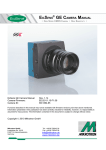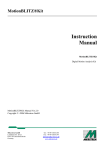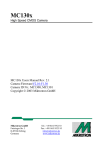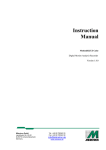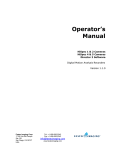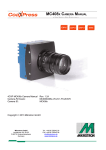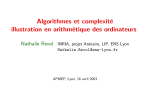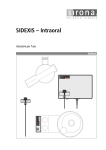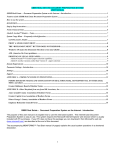Download Mikrotron MC132x Specifications
Transcript
MC132x High Speed CMOS GigE Vision Camera MC132x Users Manual Rev. 0.23 Camera-Firmware: B2.02-V2.16-F0.81 Kamera ID Nr.: MC1324 .. MC1327 Copyright © 2006, 2007 Mikrotron GmbH Mikrotron GmbH Landshuter Str. 20-22 D-85716 Unterschleißheim Germany Tel.: +49 89 726342 00 Fax: +49 89 726342 99 [email protected] www.mikrotron.de General MC132x Users Manual Rev. 0.23 Table of contents 1 General..........................................................................................................................4 1.1 1.2 1.3 1.4 1.5 1.6 1.7 2 Introduction...................................................................................................................7 2.1 2.2 2.3 2.4 3 For customers in the U.S.A. .................................................................................................................................... 4 For customers in Canada ......................................................................................................................................... 4 Pour utilisateurs au Canada ..................................................................................................................................... 4 Life Support Applications ....................................................................................................................................... 4 Declaration of conformity ....................................................................................................................................... 5 Warranty Note......................................................................................................................................................... 6 Remarks, Warnings ................................................................................................................................................. 6 Top level specifications........................................................................................................................................... 7 Electronic „Freeze Frame“ Shutter.......................................................................................................................... 7 Differences between the camera types .................................................................................................................... 8 Using the camera..................................................................................................................................................... 8 Hardware.......................................................................................................................9 3.1 GigE Vision® Interface........................................................................................................................................... 9 3.1.1 Serial command interface ................................................................................................................................... 9 3.1.2 GENICAM® command interface....................................................................................................................... 9 3.2 Power supply........................................................................................................................................................... 9 3.3 Status LED .............................................................................................................................................................. 9 4 Getting started.............................................................................................................11 4.1 5 Initial setup .................................................................................................................12 5.1 5.2 5.3 5.4 5.5 6 First steps .............................................................................................................................................................. 11 Serial number and firmware revision .................................................................................................................... 12 PowerUpProfile..................................................................................................................................................... 12 Camera Profile ...................................................................................................................................................... 12 Factory profile....................................................................................................................................................... 12 User profile............................................................................................................................................................ 12 Configuration..............................................................................................................13 6.1 6.1.1 6.1.2 6.1.3 6.1.4 6.2 6.2.1 6.2.2 6.2.3 6.2.4 6.2.5 6.3 6.3.1 6.3.2 6.3.3 6.4 6.4.1 6.4.2 6.4.3 6.5 6.5.1 6.5.2 6.5.3 6.5.4 6.5.5 6.6 6.6.1 Commands............................................................................................................................................................. 13 Table of commands .......................................................................................................................................... 14 RESET of the camera ....................................................................................................................................... 14 Acknowledge response..................................................................................................................................... 14 Baud rate........................................................................................................................................................... 15 Read camera information ...................................................................................................................................... 15 Read serial number and firmware revision ....................................................................................................... 15 Read identifier .................................................................................................................................................. 15 Read complete camera settings......................................................................................................................... 16 Read single values of camera setting................................................................................................................ 17 Reading camera temperature ............................................................................................................................ 17 Profile processing.................................................................................................................................................. 18 Write user profile.............................................................................................................................................. 18 Load user profile .............................................................................................................................................. 18 Load factory profile.......................................................................................................................................... 19 Image quality......................................................................................................................................................... 19 FPN................................................................................................................................................................... 19 Gain .................................................................................................................................................................. 19 Black Level....................................................................................................................................................... 19 Image size and position ......................................................................................................................................... 20 Address of the first line .................................................................................................................................... 20 Number of lines ................................................................................................................................................ 20 Address of the first pixel of a line .................................................................................................................... 20 Address of the last pixel of a line ..................................................................................................................... 21 Tracking ........................................................................................................................................................... 21 Clock selection ...................................................................................................................................................... 21 Arbitrary selection of sensor and pixel clock ................................................................................................... 22 2 General MC132x Users Manual Rev. 0.23 6.6.2 Image Format/Speed change ............................................................................................................................ 22 6.7 Exposure control ................................................................................................................................................... 22 6.7.1 Type of exposure .............................................................................................................................................. 22 6.7.2 Frame rate with synchronous exposure ............................................................................................................ 23 6.7.3 Synchronous operation without shutter ............................................................................................................ 23 6.7.4 Synchronous operation with shutter ................................................................................................................. 24 6.7.5 External synchronisation with synchronous exposure...................................................................................... 24 6.7.6 Frame rate with asynchronous exposure........................................................................................................... 25 6.7.7 Asynchronous exposure, shutter control by pulse width .................................................................................. 25 6.7.8 Asynchronous exposure, shutter control by timer ............................................................................................ 25 6.8 Extended command features ................................................................................................................................. 25 6.9 Special fpga registers ............................................................................................................................................ 26 6.10 Firmware ............................................................................................................................................................... 26 6.10.1 Update firmware microcontroller application.............................................................................................. 26 6.10.2 Update FPGA firmware............................................................................................................................... 27 6.10.3 Firmware update procedure ......................................................................................................................... 27 6.11 Horizontal pixelbinning......................................................................................................................................... 28 6.12 Vertical pixelbinning............................................................................................................................................. 28 6.13 Digital gain............................................................................................................................................................ 28 6.14 External clock input .............................................................................................................................................. 29 6.15 Polarity of EXP-signal .......................................................................................................................................... 29 6.16 Test image ............................................................................................................................................................. 29 6.17 Image counter........................................................................................................................................................ 29 6.18 ImageBLITZ® shutter release............................................................................................................................... 30 6.18.1 ImageBLITZ® processing ........................................................................................................................... 30 6.18.2 ImageBLITZ® programming ...................................................................................................................... 30 6.18.3 ImageBLITZ® registers .............................................................................................................................. 33 6.18.4 ImageBLITZ® setup.................................................................................................................................... 33 7 MC13xx configuration tool ........................................................................................34 7.1 7.2 8 Basic Configuration............................................................................................................................................... 34 ImageBLITZ® Configuration ............................................................................................................................... 35 Mechanical dimensions ..............................................................................................36 8.1 Camera body MC132x .......................................................................................................................................... 36 8.1.1 Dimensioned drawing, side view of MC1324/25 ............................................................................................. 36 8.1.2 Dimensioned drawing, side view of MC1326/27 ............................................................................................. 36 8.1.3 Dimensioned drawing, front view of MC1324/25............................................................................................ 37 8.1.4 Dimensioned drawing, front view of MC1326/27............................................................................................ 37 8.1.5 Dimensioned drawing, rear view of MC132x .................................................................................................. 38 8.2 Lens adjustment .................................................................................................................................................... 38 8.2.1 Lens adaption ................................................................................................................................................... 38 8.2.2 Adjustable lens adapter, only for camera models with C-mount flange ........................................................... 38 8.2.3 Lens selection for camera types with C-mount flange (see table overview of cameras) .................................. 38 9 Technical Data ............................................................................................................39 9.1 9.2 9.3 9.3.1 9.3.2 9.4 9.4.1 9.5 Spectral response................................................................................................................................................... 40 Sensitive area of a pixel ........................................................................................................................................ 41 Connector pinning ................................................................................................................................................. 42 Gigabit Ethernet Connector .............................................................................................................................. 42 Circular power connector, 12-pin ..................................................................................................................... 42 Frequency selection............................................................................................................................................... 43 Table of clock frequency codes ........................................................................................................................ 43 Programming sequence, factory profile f3 ............................................................................................................ 45 3 General MC132x Users Manual Rev. 0.23 1 General 1.1 For customers in the U.S.A. This equipment has been tested and found to comply with the limits for a Class A digital device, pursuant to Part 15 of the FCC Rules. These limits are designed to provide reasonable protection against harmful interference when the equipment is operated in a commercial environment. This equipment generates, uses, and can radiate radio frequency energy and, if not installed and used in accordance with the instruction manual, may cause harmful interference to radio communications. Operation of this equipment in a residential area is likely to cause harmful interference in which case the user will be required to correct the interference at his own expense. You are cautioned that any changes or modifications not expressly approved in this manual could void your authority to operate this equipment. The shielded interface cable recommended in this manual must be used with this equipment in order to comply with the limits for a computing device pursuant to Subpart J of Part 15 of FCC Rules. 1.2 For customers in Canada This apparatus complies with the Class A limits for radio noise emissions set out in Radio Interference Regulations. 1.3 Pour utilisateurs au Canada Cet appareil est conforme aux normes Classe A pour bruits radioélectriques, spécifiées dans le Règlement sur le brouillage radioélectrique. 1.4 Life Support Applications These products are not designed for use in life support appliances, devices, or systems where malfunction of these products can reasonably be expected to result in personal injury. Mikrotron customers using or selling these products for use in such applications do so at their own risk and agree to fully indemnify Mikrotron for any damages resulting from such improper use or sale. 4 General MC132x Users Manual Rev. 0.23 1.5 Declaration of conformity Manufacturer: Mikrotron GmbH Address: Landshuter Str. 20-22 85716 Unterschleissheim Deutschland Product: camera MC1324, MC1325, MC1326, MC1327 The dedicated products conform to the requirements of the Council Directives 2004/108/EG for the approximation of the laws of the Member States relating to electromagnetic consistency. The following standards were consulted for the conformity testing with regard to electromagnetic consistency. EC regulation Description EN 61000-6-3 EN 61000-6-1 Electromagnetic compatibility Immunity Unterschleissheim, August 04th. 2006 Mikrotron GmbH Dipl.-Ing. Bernhard Mindermann President of Mikrotron 5 General MC132x Users Manual Rev. 0.23 1.6 Warranty Note Do not open the body of the camera. The warranty becomes void if the body is opened. 1.7 Remarks, Warnings This document contains important remarks and warnings. See the corresponding symbols: L * Important remark Attention, Warning 6 Introduction MC132x Users Manual Rev. 0.23 2 Introduction The CMOS high speed camera MC132x is a high resolution camera with 1280 x 1024 pixel. Benefits of CMOS technology are high speed, random access to pixels with free programmability and low power. The camera uses industry-standard C-Mount lenses. The sensor diagonal is 1,25“ with square pixels measuring 12µm. Free programmability means that the user is free to define the region of interest by size and position and the speed of data output. The frame rate can be selected between 25 fps and several thousand fps depending on resolution and video data width. With a resolution of 1280 x 1024 pixel, 80 fps can be output via the Gigabit Ethernet Interface. Parameter sets are called “profiles” and stored in non volatile memory. 2.1 Top level specifications • • • • • • • • • • • • • • high resolution: 1.280 x 1.024 pixel CMOS sensor with 1300 A/D converters up to 1.024 gray levels up to 80 full frames/s up to 500 frames/s using data reduction algorithms arbitrary region of interest high sensitivity 12μm square pixels electronic “Freeze Frame” shutter low blooming programmable via serial link patented ImageBLITZ® image trigger asynchronous trigger download customer specific FPGA preprocessing firmware small, compact housing wide power supply range 2.2 Electronic „Freeze Frame“ Shutter Preceding exposure, the contents of all light sensitive elements is cleared. When exposure terminates, accumulated charge is transferred to an analog memory associated which each pixel. It stays there until it is read out (and discharged) by the A/D conversion cycle. As all light sensitive elements are exposed at the same time, even fast moving objects are captured without geometric distortion. 7 Introduction MC132x Users Manual Rev. 0.23 2.3 Differences between the camera types The CMOS cameras are available in different versions depending on the supported features monochrome/color or Base/Full Camera Link ® interface, lens connection to C-mount or changeable lens adapter C-mount/F-mount. Features Data width Type (bits) MC1324 MC1325 MC1326 MC1327 8 8 8 8 Color/ Mono M C M C Max BWidth 110 Mbyte/s 110 Mbyte/s 110 Mbyte/s 110 Mbyte/s C/F-Mount max. frame rate@ Imagelens adaption 1280 x 1024 BLITZ® C C F F Table 2.3-1 80 fps 80 fps 80 fps 80 fps Image preprocessing supported + + + + + + + + + ... supported - ... not supported 2.4 Using the camera There are no serviceable parts inside the camera.. The camera may not be opened, otherwise guarantee is lost. Use dry, soft lens-cleaning tissue for cleaning lenses and, if necessary, the sensors window. 8 Hardware MC132x Users Manual Rev. 0.23 3 Hardware 3.1 GigE Vision® Interface GigE Vision® is designed for digital cameras in machine vision applications. This interface can transfer data at a rate of 110 Mbytes/sec. The GigE Vision® chipset and software is designed and implemented by Pleora Tech. Inc. the leading supplier of GigE Vision technology. Please refer to the PT1000 documentation for further information. 3.1.1 Serial command interface The camera is controlled by an ascii-based serial protocol, wrapped by the Pleora IPORT engine. 3.1.2 GENICAM® command interface Implemented camera specific GENICAM® features: Feature name CameraHeadSensorClock CameraHeadPixelClock CameraHeadDigitalGain CameraHeadSaveAsPowerUp CameraHeadReset Corresponding serial command :S4xxxxx :S6xxxxx :r700x :pc :c Reference Clock selection Clock selection Digital gain Profile processing RESET of the camera 3.2 Power supply The camera needs a DC supply voltage between 8 … 24 V at a power consumption of 5,0 Watt max. See also Connector pinning . * Before applying power to the camera we strongly recommend to verify the used pins of the power connector, the polarity (+/-) of the leads and the supply voltage. The camera may only be used with a supply voltage according to the camera specification. Connecting a lower or higher supply voltage, AC voltage, reversal polarity or using wrong pins of the power connector may damage the camera. If doing so, the warranty will expire immediately. 3.3 Status LED A dual colour LED on the camera backplane shows the operating condition of the MC132x. LED orange... The MC132x is configuring the internal FPGA. No other activity is possible. 9 Hardware MC132x Users Manual Rev. 0.23 LED green... The MC132x is fully operational. LED off... If LED is off, despite the camera is powered, the FPGA configuration data is reloaded via the serial interface and stored in internal EEPROM. No other activity is possible. red LED that the FPGA could not be loaded because of wrong FPGA configuration data. Try to reload configuration data. LED red... 10 Getting started MC132x Users Manual Rev. 0.23 4 Getting started Before starting to operate the camera, make sure that the following equipment is available: • • • • Camera MC132x C-Mount/F-Mount Lens Mikrotron Support CD Image processing system, e.g.: PC and Software L For GigE Interface the Intel MT1000 Chipset is recommended Additional items: • 1 GigE cable (CAT6 recommended) • 1 Power supply 12VDC, 0.5A min • 1 power cable L To specify cables see chapter Connector pinning. 4.1 First steps 1. 2. 3. 4. 5. Switch off the image processing system Connect GigE cable between camera and PC. Connect power cable. Unscrew dust protection cover, screw in lens. Switch on the image processing system and camera power supply 11 Initial setup MC132x Users Manual Rev. 0.23 5 Initial setup The MC132x is delivered with initial parameters and therefore does not need to be configured via the serial link. 5.1 Serial number and firmware revision Serial number and firmware revision is provided in MC132x non volatile memory. Use :v command (Read serial number and firmware revision) to read serial number and firmware revision. The serial number is also marked on the type plate of the camera. 5.2 PowerUpProfile The PowerUpProfile is the setting of all registers, which is loaded from non-volatile memory during power-up and software reset. The content of the PowerUpProfile is loaded into the Camera Profile. 5.3 Camera Profile The actual set of parameters is called Camera Profile. All changes of parameters by the serial link is reflected in the Camera Profile. The Camera Profile can be saved to 8 user profiles or one PowerUpProfile by command. It is loaded from 8 user profiles or 8 factory profiles or the PowerUpProfile. The camera profile is volatile and must be stored to the PowerUpProfile to be reactivated on next power up or software reset. 5.4 Factory profile The factory profile can be read but not written by the user. They are factory preset to the settings of table below. Profil-Nr. Resolution in pixel 0 1 2 3 4 5 6 7 100 x 100 240 x 240 640 x 480 1280 x 1024 640 x 480 1280 x 1024 640 x 480 1280 x 1024 Data width per Pixel in bit 8 8 8 8 8 8 10 10 Frame rate in fps 4.852 1.011 202 47 202 47 48 23 Video data width in Mbyte/s 48,5 58,2 62,1 61,6 62,1 61,6 28,1 57,5 Table 5-1 5.5 User profile The user can store up to eight User profiles in non volatile memory. All load or write commands exchange data between the PowerUpProfile and one of the four user profiles. The user profiles are factory preset to the factory profiles. 12 Configuration MC132x Users Manual Rev. 0.23 6 Configuration The MC132x has 15 FPGA registers, r1..rfh , each 10 bit wide, 16 x 32bit registers, eight D/A registers, a1..a8, 8-bit wide, and two clock code registers, each 3 x 8bit wide. The contents of all the above registers is called a profile. There is space in non volatile memory for 17 profiles: one PowerUpProfile, 8 user profiles and 8 factory profiles. Any change of a specific register through the serial interface is immediately processed and written to the volatile part of the memory and gets lost when power goes down. A command must be used to store the actual setting in non volatile memory. After power-up the PowerUpProfile is loaded from the nonvolatile to the volatile part of the memory (Camera profile). A load or write command exchanges data between the PowerUpProfile and one of the eight user profiles. The eight factory profiles can be read but not be written by any command. All values are given in hexadecimal notation, e.g.: 0xff or 0ffh = 255. 6.1 Commands ASCII strings are used to change camera parameters. All commands start with a colon, followed by one selection character and a value in hexadecimal notation with two or three ASCII characters. After a command has been recognized, processing is immediate, for all commands but the save type commands (:px). These need a EEPROM write time of app 1ms. An answer is provided with read type commans (:v, :w, :W) or, if the command “command acknowledge flag” is set, after processing of each command an ACK or NAK character. Processing of wrong command is stopped immediately on recognizing the error. A new command must start with a colon. 13 Configuration 6.1.1 MC132x Users Manual Rev. 0.23 Table of commands Syntax :a<n><xx> Range <n> = 1...8 <xx> = 0...ffh <n> = „y“,“Y“,“n“,“N“ :A<n> :b<n> Answer ACK* ACK* <n> = 0...4 ACK* -- ACK* :c :e... :ERASE<ccc> -<ccc> = “APP”, “EPCS1” :f<n> <n> = 0...7 ACK* :g<n> :l<nn><xxxxxxxx> <n> = 0...7 <nn>=00..02 <xxxxxxxx>=32bit value <n> = 0...7 ACK* ACK* <n> = 1...fh <xxx>= 000...3ff <xxxxxx> = 6 Byte Code <n> = 00..7fh <m> = 00..ffh --- ACK* :p<n> :r<n><xxx> :S<xxxxxx> :t<n><m> :T :v :V :w :W :Z<c><…> --- ACK* ACK* ACK* +50.5 #12345-B2.02-V1.10F1.29 -1324000003433 -camera profile: 44 bytes in hex -Camera profile: 44 bytes in ASCII <c> = “a”, “c”, “l”, “r” register value in ascii, <…>= register no., depending different formats on <c> ACK* … 6.1.2 RESET of the camera Description Set one of eight analog voltages for the sensor En- or disable a command acknowledge or not acknowledge (ACK or NAK) Select baud rate: 0=9600 Bd (default setting), 1=19.2 kBd, 2=38.4 kBd, 3=56.8 kBd, 4=115.2 kBd RESET and new Initialization of the camera, new load of PowerUpProfile. Duration: some seconds Transmit & save a new FPGA configuration Erase of camera internal firmware, CAMERA STOPS WORKING, READ COMMAND DESCRIPTION BEFORE EXECUTING ! Reload one of eight, factory defined and calibrated profiles to PowerUpProfile. Reload one of eight user profiles to PowerUpProfile Extended registers for special use (e.g. direct input of camera settings), 32 bit values, as 6 ASCII char Save PowerUpProfile to one of eight user profiles, allow app. 1ms save time. Write a FPGA - register Program sensor and pixel clock directly. Short setting of X- position in units of 10 pixel and Yposition in units of 4 lines. Read temperature Read serial number (#) and firmware versions Read identifier Read actual Camera Profile, data output in hex Read actual Camera Profile, data output in ASCII Read single register values ACK (acknowledge, 06 hex) or NAK (not acknowledge, 15 hex) will only be sent if the response was enabled first by command :A<n>. For reconfiguring the camera without power down/up there is a command for resetting the camera. The camera will start-up new, configure fpga and load the power-up profile. Additionally some volatile settings will be adjusted to the default values, e.g. baud rate. Command: :c camera reset Response: ACK if enabled by separate command :A<n> 6.1.3 Acknowledge response Several commands do only adjust the camera without any response of the camera. To get an answer of the camera an acknowledge response can be en- or disabled. The default setting for camera start-up is “no response”. After power-up or reset of the camera the Acknowledge response is disabled. The response is volatile and must be separately enabled by the following command. Command: :A<n> <n> = “Y”, “y”, “N”, “n” “Y”, “y” … response enabled “N”, “n” … response disabled 14 Configuration Response: MC132x Users Manual Rev. 0.23 if command is “:AY” or “:Ay” ACK = 06 hex, in hex NAK = 15 hex, in hex All commands, which can answer with a acknowledge reponse are shown in the command table. * ACK Provided that acknowledge response is enabled, the camera will only send ACK or NAK if it receives a known command structure with at least a colon. Sending any characters without command syntax will not be responded. 6.1.4 Baud rate The baud rate of the serial communication may be adjusted from low to higher speed. The camera always starts with 9.600,8,n,1,- (9.600 Bd, 8 data bits, no parity, 1 stop bit). The adjustment of the baud rate can be changed, but the setting is volatile and will be reset to 9.600 Bd if power-up or reset of the camera occurs. Command: :b<n> <n> = 0 ... 4 0 = 9.600 Bd (default, power-up, reset) 1 = 19.200 Bd 2 = 38.400 Bd 3 = 57.200 Bd 4 = 115.400 Bd Response: ACK if enabled by separate command :A<n> 6.2 Read camera information 6.2.1 Read serial number and firmware revision The serial number and the firmware revision can be read with the :v command. Command: Response(e.g.): :v #01234-B2.02-V2.02-F0.71 Serial number of the camera Microcontroller bootloader firmware version 6.2.2 FPGA firmware version Microcontroller application firmware version Read identifier The identifier offer information about the camera type and camera functions. It consists of 8 bytes, which are delivered as 16 ascii characters. Command: Response (e.g.): :V 1324000000000000 definition of additional functions or features, 4 bytes camera type, e.g. 1324 = MC1324 15 Configuration MC132x Users Manual Rev. 0.23 Definition of functions or features: cccc0000000000ss 00 … not defined cccc … camera type of camera label at the rear housing of the camera, e.g. 1324, 1325, 1326, 1327 ss … sobel filter Function bit not used not used not used Sobel bin+dir (2bit per pixel) Sobel binary (1bit per pixel) Sobel bin+dir (8bit per pixel) Sobel (8bit per pixel) Target data (proprietary) 7 6 5 4 3 2 1 0 value of each bit of ss in hex 80 40 20 10 08 04 02 01 description 1 … enable, 0 … disable 1 … enable, 0 … disable 1 … enable, 0 … disable 1 … enable, 0 … disable 1 … enable, 0 … disable 1 … enable, 0 … disable 1 … enable, 0 … disable 1 … enable, 0 … disable Example: Sobel filter with all features: ss = ff 6.2.3 Read complete camera settings The complete, actual camera settings can be read out . The answer are the values of all camera registers. Command: :w :W Output as hexadecimal digits Output as ASCII-String Example for ":w" (output as hex digits, 110 Databytes + CR + LF): 6d6448c66500650061008541898c0000 03f f03f f0000007f 0030000000000000 00000000000000000000000000000000 00000000000000000000000000000000 00000000000000000000000000000000 00000000000000000000000000000000 000000000000000000000000↵ 15x10bit registers r1... rf 16x32bit registers m0...mf CR+LF Example for ":W" (output as ASCII string, 91 Bytes total, 88 databytes, 1x CR preceding the databytes, 1x CR after 32 ASCII-characters and 1x CR after 64 ASCII- characters): ↓6d6448c66500650061008541898c0000↓ 03f f03f f0000007f 0030000000000000↓ 00000000000000000000000000000000↓ CR 00000000000000000000000000000000↓ 00000000000000000000000000000000↓ 00000000000000000000000000000000↓ 000000000000000000000000↵ Assignment of data to camera parameters: analog settings 6d6448c665006500 61008541898c 0000 03f f03f f0000007f 0030000000000000 000000000000000000000000↵ Codes for pixeland Sensorclock image size & position 16 Configuration MC132x Users Manual Rev. 0.23 Transmitted bytes: A1 A2 A3 A4 A5 A6 A7 A8 Sa1 Sa2 Sa3 Sb1 Sb2 Sb3 R1h R1l ... R15h R15l M0hh M0hl M0lh M0ll … Mfhh Mfhl Mflh Mfll↵ A1...A8 Sa1 Sa2 Sa3 Sb1 Sb2 Sb3 R1…R15 R1h ... R1l ... M0…Mf M0hh M0hl M0lh M0ll ↵ ... analog settings 3 Bytes frequency codes of pixelclock 3 Byte frequency codes for sensorclock image size & position (r registers) high Byte Register1 low Byte Register1 fpga registers (m registers) 1. byte of m register no. 0, MSB 2. byte of m register no. 0 3. byte of m register no. 0 4. byte of m register no. 0, LSB CR+LF (0dh + 0ah) (see 6.7) (see 6.7) Abb. description hex. Code CR carriage return 0d LF line feed 0a 6.2.4 Read single values of camera setting All camera internal registers of settings may also be read as single values. Command: :Z<c><xx> request for single register value of camera setting <c> … ‘a’, ‘c’, ‘r’, ‘m’ (ascii characters) <xx> … extension, which can differ in dependence of the wanted camera setting Valid commands: :Za<n> output of value of analog register, in ascii characters <n> … 1 - 8 (ascii character) output of sensor clock code output of pixel clock code output of fpga registers r, <xx> … 01 – 0f (hex, in ascii characters) output of special fpga registers m, <n> … 0 – f (hex, in ascii characters) :Zcs :Zcp :Zr<xx> :Zm<n> Response: for :Za<n> for :Zcs for :Zr<xx> for :Zm<n> , e.g. 6d↓ , e.g. 41bb0b↓ , e.g. 03ff↓ , e.g. 00000000↓ (hex, 2 ascii characters + CR) (hex, 6 ascii characters + CR) (hex, 4 ascii characters + CR) (hex, 8 ascii characters + CR) or for incomplete or invalid command (e.g. :Zx): command :A<n> 6.2.5 NAK if enabled by separate Reading camera temperature To control the temperature inside , the camera disposes of an internal temperature sensor. The temperature inside the camera can be read out in steps of 0.5°. The value is delivered in ASCII characters signed. Command: :T 17 Configuration MC132x Users Manual Rev. 0.23 Response(e.g.): +34.0 The temperature sensor is able to deliver values of –128°C to +128°C. * Take care that the temperature of the camera does not exceed the specified case temperature range. 6.3 Profile processing All camera settings are loaded or stored as complete data blocks (= Profiles). There are 17 profiles, the Camera profile, the PowerUpProfile, eight factory profiles and eight user profiles. PowerUpProfile factory profiles 0...7 user profile 0 :pc user profile 1 user profile n user profile 7 :p0 :p1 :pn :p7 :g0 :g1 :gn :g7 f0..7 :gc or power on camera profile (programs to camera logic) configuration commands :a..z[parameter] 6.3.1 Write user profile The Camera Profile is transferred to one of the eight user profiles (0…7) or the power-up profile (c). The user profiles are located in non volatile memory. Command: Response: L 6.3.2 :p<n> ACK <n> = 0 ... 7,c if enabled by separate command :A<n> Issue this command only, if the Camera Profile was successfully tested. Load user profile Load one of eight user profiles or the power-up profile, which are located in non volatile memory, to the Camera Profile. Additionally all registers will be programmed with the new values. Command: Response: :g<n> ACK <n> = 0 ... 7, c if enabled by separate command :A<n> 18 Configuration 6.3.3 MC132x Users Manual Rev. 0.23 Load factory profile The eight factory profiles, located in non volatile memory, can be read but not changed by the user. With this command factory profile no. <n> is loaded into Camera Profile. Additionally all registers will be programmed with the new values. Command: Response: :f<n> ACK <n> = 0 ... 7 if enabled by separate command :A<n> 6.4 Image quality There are eight analog parameters to adjust the first stage of the sensor and influence image quality. Five of them are calibrated for getting excellent image quality and should not be changed. Three parameters are also preset for good image quality. Although it’s not necessary to change them, it can be useful to optimize them depending on the used camera mode and speed. The three parameters are FPN, Gain, and Black up. 6.4.1 FPN The Fixed Pattern Noise setting reduces the fixed pattern noise that is typical to CMOS sensors. This level might be changed if the sensor clock frequency is changed. For adjustment set the lens out of focus and to a medium grey level. Lower FPN until a heavy pattern appears. Then raise by a few points. Command: :a1<x1x0> Response: Example: ACK :a164 6.4.2 <x1x0> : Range 00 .. ff (hex), typ. 55h ... 80h, ASCII char if enabled by separate command :A<n> set register a1 to 64 (hex) Gain This is the threshold for the A/D converters. To increase the gain the value of a2 must be lowered. Values below 30h will lead to oversensitive images and are not recommended to set. Command: :a2<x1x0> Response: Example: ACK :a264 <x1x0> : Range 00 ... ff (hex), typ. 30 ... 80 (hex), ASCII char if enabled by separate command :A<n> set register a2 to 64 (hex) 6.4.3 Black Level If no Black Level is adjusted (= 00 hex), each pixel will have an offset, which reduces the contrast. For excellent image quality it’s recommended to adjust Black Level to subtract this offset from each pixel value. For adjustment of the Black Level it’s recommended to darken the sensor (closed lens) and increase the Black Level value till all pixel values are touching 0 level. The Black Level can vary slighty with changing the sensor clock and should be optimized for each selected speed. Command: :a5<x1x0> Response: ACK <x1x0>: Range, typ. 00h ...ff (hex), typ. 30… 80 hex ASCII char if enabled by separate command :A<n> 19 Configuration MC132x Users Manual Rev. 0.23 6.5 Image size and position Image size and position within the sensor is defined by four parameters: Bit(s) r1[9..0] r3[9..0] r4[6..0] r5[6..0] 6.5.1 Description Number of first line, 0..3FDh Number of lines, 0..3FFh Address/10 of the first pixel Address/10 of the last pixel Table 6.5-1 Address of the first line Register r1 defines the vertical start position of the ROI (region of interest ) within the sensor size. It’s the first line to be displayed. Command: Response: :r1<x2x1x0> ACK <x2x1x0> ... Range 000h ...3fdh if enabled by separate command :A<n> Example: :r1100 = 256 (dec) + 1 Ö image starts at line 257 L 6.5.2 If dual column binning is activated, r1 is doubled within the camera logic. Number of lines Register r3 defines the vertical size of the ROI (region of interest ) within the sensor size. It’s the number of lines to output. Command: Response: :r3<x2x1x0> ACK <x2x1x0> ... Range 000 h ...3ffh if enabled by separate command :A<n> Example: :r31ff = 511 (dec) +1 L 6.5.3 Ö display 512 lines The sum of r1 and r3 must be ≤ 0x3ff/1023 or 0x1ff/511 if dual column binning is activated! Address of the first pixel of a line Register r4 defines the start of horizontal start position of the ROI (region of interest ) within the sensor size. It’s the leftmost pixel. The value is the pixel address divided by ten. Command: Response: :r4<x2x1x0> ACK <x2x1x0> ... Range 000h ...7fh if enabled by separate command :A<n> Example: :r4020 = 32 (dec) * 10 Calculation of the value of r4: Ö line start at pixel 320 (dec) Value of r4 = Pixel-Nr./10 20 Configuration 6.5.4 MC132x Users Manual Rev. 0.23 Address of the last pixel of a line Register r4 defines the horizontal end position of the ROI (region of interest ) within the sensor size. It’s the rightmost pixel. The value is the pixel address divided by ten. Command: Response: :r5<x2x1x0> ACK <x2x1x0> ... Range 000h ...07fh if enabled by separate command :A<n> Example: :r505f = 95 (dec) * 10 Ö line end at pixel 790 (dec) Calculation of the value of r5: Value of r5 = Pixel-Nr./10 Calculation of horizontal size: e.g.: r4 = 010, r5=04f (r5 – r4 + 1) * 10 (95 - 32 + 1) * 10 = 640 pixel per line L 6.5.5 The difference r5 - r4 must be in the range: 0 ≤ r5-r4 ≤ 7fh . Tracking For rapid window movement even at slow baud rates a short command is provided.. command: :t<n>,<m> <m> = X-position in pixel/10, range 00h ...07fh <n> = Y-position in lines / 4, range 00h ...0ffh Response: ACK if enabled by separate command :A<n> 6.6 Clock selection The MC132x is equipped with a 2-channel programmable clock synthesizer. One channel controls clock frequency of the sensor (sensorclock, Fsens), the other controls the frequency of the pixel clock (pixelclock, Fpix). These independent clocks allow an always optimal ratio depending on the product of (image size x image frequency) and the data rate on the output. As the sensor outputs 10 pixel per clock a sensor clock of 6.6MHz could be chosen. Because the sensor can run up to a clock frequency of 66 MHz only 1/10 of the sensors possible speed would be used. To make use of the maximum sensor clock and maintaining the maximum data rate on the output, just 120 (1280/10 rounded to steps of 10) from the possible 1280 pixel per line can be selected. Therefore the ratio of Fsens and Fpix depends on the selected line length: Fsens <= (Fpix • 1280) / (5 • line length) or if 100 pixel line length is chosen: Fsens = (33 • 1280) / (5 • 100) = 70,4 MHz As this exceeds the maximum sensor clock frequency, Fsens is chosen as 66 MHz and Fpix as 33 MHz. 21 Configuration 6.6.1 MC132x Users Manual Rev. 0.23 Arbitrary selection of sensor and pixel clock Sensor and pixel clock can be set to any value, the product of: (sensor clock • line length/1280) must always be smaller (about 10%) than the qoutient: (pixel clock / 2). Command :S <x0> Response: ACK 6.6.2 <x0> ... 6 characters, as described in chapter Frequency selection if enabled by separate command :A<n> Image Format/Speed change There are several steps necessary for a change of image format: i. Disable sensor controller with :r6[4] = 0. ii. Set image size with (:r1,:r2, :r3, :r4, :r5). iii. If new sensor clock = old sensor clock: 1. Do not set pixel clock nor sensor clock. iv. If new sensor clock > old sensor clock: 1. Set new pixel clock (:S6…..), then new sensor clock (:S4….). v. If new sensor clock < old sensor clock: 1. Set new sensor clock (:S4…..), then new pixel clock (:S6….). vi. Reenable sensor controller (:r6[4]=1). 6.7 Exposure control Exposure control is selected with register r6[7..4] and register r2[9..0]. Bit(s) r6[7..4] r2[9..0] Description Type of exposure Exposure time table 6-1 6.7.1 Type of exposure The MC132x can expose the images synchronous or asynchronous. An external signal on CC1 can be used to synchronize MC132x cameras to each other or to an external event. 6.7.1.1 Synchronous exposure Synchronous exposure means that the next image is exposed, while the current image is output. This mode provides fastest frame rate while maintaining maximum exposure time as long as 1/frame rate. If an external synchronization signal is input on CC1 its frequency range can be between 30Hz and the selected free running frame rate. Use MC13xx camera configuration tool for selection. 6.7.1.2 Asynchronous exposure With asynchronous exposure, an external signal starts exposure, and the exposed image is output immediately after the exposure ends. Exposure time is defined either by an internal timer or by the width of the external EXP (CC1) signal. The time between two consecutive EXP (CC1) edges can be indefinite. 22 Configuration MC132x Users Manual Rev. 0.23 Frame rate = 1/(exposure time + image output time). Image output time equals the selected free running frame rate. Use MC13xx camera configuration tool for selection. The following registers select exposure type: Register Bits :r6[7..4] camera stop xxx0 Synchronous without elec0001 tronic shutter Synchronous with electronic 0011 shutter Synchronous with electronic 0011 shutter and external synchronisation signal, positive edge Synchronous with electronic 0011 shutter and external synchronisation signal, negative edge Asynchronous, pulsewidth, 1011 positive edge Asynchronous, pulsewidth, 1011 negative edge Asynchronous, timer, positive 1111 edge Asynchronous, timer, nega1111 tive edge Table 6.7-1 :r7[8] x 0 :rf[0] x 0 0 0 0 1 1 1 0 0 1 0 0 0 1 0 6.7.2 Frame rate with synchronous exposure The frame rate with synchronous exposure is direct proportional to the selected number of lines. The time for one line is: Tzz = 1/Fsens • 136 [sec] Tzz ...time/line Fsens... Sensorclock = 1 / (time/line • number of lines+1) or: = Fsens/ (136 • (r3[9..0] +2)) Dependencies between image size and frame rate for typical clock frequencies are given in the following table: image size 100x100 240x240 640x480 1280x1024 Frame rate: Sensorclock (MHz) Time/line [µs] Frames/s 66 33 2,06 4,12 4.852 1.011 Table 6.7-2 13,2 10,3 202 6,6 20,6 47 6.7.3 Synchronous operation without shutter Without electronic shutter the exposure time is 1 / frame rate. 23 Configuration MC132x Users Manual Rev. 0.23 6.7.4 Synchronous operation with shutter In the sensor is implemented a freeze frame shutter, which allows to reduce the exposure time in steps of one line. The minimum value of the exposure time is the duration of 2 line periods, which is determined by the value of r2 (min. 001h). Command: Response: :r2<x2x1x0> ACK <x2x1x0> ... Range 001h ...3ffh if enabled by separate command :A<n> Exposure time TB : TtB = r2 • TZZ -TZZ / 2 TB ... r2 ... TZZ ... exposure time in s value of register 2 time/line Tzz = 1/Fsens * 136 Ttzz ... Time/line Fsens... sensor clock B [s] Typical exposure times: Sensor clock frequency (MHz) 66 33 13,2 6,6 6.7.5 Time/line r2 (µsec) @ 1/5.000 s 2,06 97 4,12 49 10,3 19 20,6 10 Table 6.7-3 r2 @ 1/10.000 s 49 24 10 5 External synchronisation with synchronous exposure MC132x cameras can be synchronized to an external signal that is input on the EXP (TRIG) signal. The strobe output signal of a MC132x “master camera” can be used for that purpose. See timing diagram: Synchronous exposure with external synchronisation via TRIG The cameras frame rate must be set to a frequency slightly higher than the maximum frequency of the synchronization signal. The minimum frequency should be higher than 30Hz. Command: Response: 000 … deselect external sync signal 001 … select external sync signal This is an example for enabling this function. Depending on the wanted camera mode it can be necessary to add additional bits of this register . ACK if enabled by separate command :A<n> Command: :rf001 Response: :rf001 ACK <0> ... deselect external sync signal <1> ... select external sync signal if enabled by separate command :A<n> 24 Configuration MC132x Users Manual Rev. 0.23 Make sure that a sync signal is present on EXP/CC1 before this command is issued or the “trigger on CC1” button is pressed on the MC13xx camera configuration tool. The polarity of the sync signal can be selected with the _Polarity_of_EXP-signal 6.7.6 Frame rate with asynchronous exposure The frame rate with asynchronous exposure = Frame rate with synchronous exposure – (1 / exposure time). 6.7.7 Asynchronous exposure, shutter control by pulse width This operating mode is selected with register 6: :r6[7..4] = 0xb Exposure time depends on the width of the external EXP – signal. 6.7.8 Asynchronous exposure, shutter control by timer This operating mode is selected with register 6: :r6[7..4] = 0xf The asynchronous exposure time is dependent on :r2[9..0]. The exposure timer counts as many lines as are defined in register :r2[9..0]. Exposure time: TB = 1/Fsens * 136 • (1+r2[9..0]) TB ... exposure time Fsens.. sensor clock example: [Sec] sensor clock = 66MHz value of r2[9..0] = 6 TB = 136 • 6 • 15 ns = 12,2 µs 6.8 Extended command features For conformity to standards, e.g. GigE Vision the command structure of the camera was extended. It supports separate commands for direct input of horizontal position, horizontal size and vertical size. Command: :l<nn><xxxxxxxx> Response: ACK direct programming of additional 32bit registers <nn> … no. of register, range 00 … 02 (hex in ascii characters) <xxxxxxxx> … 32bit value of register, hex in ascii characters if enabled by separate command :A<n> Defined are following registers (command example): :l00… horizontal start position, hex value as ascii characters, range (<xxxxxxxx> = ): 00000000 … 0000007e (same value as for register r4) 25 Configuration MC132x Users Manual Rev. 0.23 :l01… horizontal size, hex value as ascii characters, range: 00000000 … 00000080, value of l01 = r5 – r4 + 1 :l02… vertical size, hex value as ascii characters, range: 00000000 … 00000500 value of l02 = r3 – r1 + 1 New inputs with command :l will only adjust the values of registers r1…rf and will not be stored separately in the camera profile. 6.9 Special fpga registers The fpga also handles 16 registers, each 32 bit wide, for setting special modes or functions inside the camera. These settings may be coupled with special features, e.g. sobel filter or customized image preprocessing inside the camera, which can be en- or disabled in dependence of camera extensions defined in the identifier. The 16th register is reserved. It can only read and contains the 4 LSB bytes of the identifier. Command: :m<n><xxxxxxxx> <n> … no. of register, in hex as ascii character, range 0…e (hex) <xxxxxxxx> … register value, in hex as ascii character, MSB…LSB, range 00000000…ffffffff (hex) if enabled by separate command :A<n> Response: ACK Example: :m012345678 The setting of the m registers may change depending on the camera functions. There are no presetting. For standard cameras the registers are preset to 0000000. If used for special features the adjustment is described in the documentation of the special feature(s). 6.10 Firmware The camera possesses programmable devices, which are working with some firmware packages. New cameras were programmed with all needed firmware packages and will not need any update. For customized firmware or additional features the camera offers the possibility to update some of the firmware versions. The procedure of updating depends on the firmware package. * Do not update more than 1 firmware at the same time. In case of updating more than 1 firmware, please start with application program, then fpga program follows. 6.10.1 Update firmware microcontroller application The microcontroller works with 2 programs, the bootloader and the application program. The bootloader is the basic program of the microcontroller, which ensures some basic functions (e.g. communication, loading application program) and cannot be changed or updated. In standard use of the camera it will never work in the bootloader program and the version cannot be read out. It’s only used for updating the application program. 26 Configuration MC132x Users Manual Rev. 0.23 The application program is the active microcontroller program in the camera, which supports communication, data handling and fpga program updates. See description of update procedure in chapter “Firmware update procedure”. 6.10.2 Update FPGA firmware MC132x’s logic is integrated into a FPGA (Field Programmable Gate Array), which’s configuration is stored in an EEPROM. Upon power up or a command the FPGA is loaded with this configuration. Configuration data can be downloaded via the serial interface. Mikrotron may provide configuration files (*.ibf) on request. After download of configuration data, this data is permanently stored in EEPROM and the FPGA is configured with the new data. Besides a power cycle, the :c command can be used to reconfigure the FPGA with the internally stored configuration data. See description of update procedure in chapter “Firmware update procedure”. 6.10.3 Firmware update procedure Before you disable the loaded firmware please ensure that you have a adequate application firmware version to load (e.g. MC132x….A202.ibf for application firmware, MC132x…F070.ibf for fpga firmware). (1) Start camera and test communication, e.g. with tool press “info camera” and wait for response (serial no. and firmware) (2) Select in menu “Write” “Write string to camera” and write command - for application firmware update: :ERASEAPP <ENTER> - for fpga firmware update: :ERASEEPCS1 <ENTER> which erases the program and for application firmware will restart the camera. * (3) (4) * (5) After this command the camera may not be able to deliver any images, load/send/store register or profile data. The status led of the camera will turn to red. For application firmware update only: The camera now starts with the bootloader program. It is displayed during start by the status led which blink one time during power up. Test communication, e.g. with MC13xx in menu “Write string to camera” and command :v. Response (e.g.): B2.02 Select in menu “Write” “Write file to camera” and choose application file MC132x*.ibf) and open it. The file transfer will start immediately. If the camera recognizes a newfirmware it will switch off the status led. Download of *.ibf file via serial link takes app. 1,5 - 2 min depending on the used camera. There should be no loss of power or communication during this time! Wait until file transfer is finished and the status led turns on. If the upload of the file was successful, the led will turn to green, otherwise it will be red. 27 Configuration (6) MC132x Users Manual Rev. 0.23 Verify version string by reading serial no. and firmware versions (command: :v). The new firmware version will be displayed as part of the version string. If the version is identical to the expected the camera is ready to use for capturing images. 6.11 Horizontal pixelbinning Pixelbinning adds the gray values of two adjacent pixels and outputs it as one pixel with double sensitivity. In X-direction only 512 pixels are needed to cover the sensors full size. To retain aspect ratio, every second line is discarded, if this feature is not disabled by setting Bit 8 of register 6 (:r61xx) or vertical pixelbinning is activated. Command: :r7010 This is an example for enabling this function. Depending on the wanted camera mode it can be necessary to add additional bits of this register . Response: ACK if enabled by separate command :A<n> If discarding of every other line is not disabled (:r61xx), the contents of :r1 is doubled in camera logic. To address a specific line on the sensor, the value written into :r1 has to be divided by two and :r3 must not exceed 1ffh. Example: To output 256 lines from line 128, set r1 = 63 and r3 = 255 (=0xff). 6.12 Vertical pixelbinning Vertical pixelbinning adds the gray values of two superimposed pixel of a column. This doubles sensitivity and vertical field of view. To retain aspect ratio, in addition horizontal binning must be activated. To activate, set bit 2 in register 6. Command: :r6034 This is an example for enabling this function. Depending on the wanted camera mode it can be necessary to add additional bits of this register . Response: ACK if enabled by separate command :A<n> 6.13 Digital gain Out of the 10-bits sensor data either the most significant 8 bits (gain 1), or bits 8..1 (gain 2), or the least significant 8 bits (gain 4) are selected. Command: :r700x x = 0: gain 1 x = 4: gain 2 x = 8: gain 4 This is an example for enabling this function. Depending on the wanted camera mode it can be necessary to add additional bits of this register. Response: ACK if enabled by separate command :A<n> 28 Configuration MC132x Users Manual Rev. 0.23 6.14 External clock input MC132x frequency synthesizer can use the Camera Link® used to synchronize several MC132x to one master clock. To activate set Bit 9 of register 7. Command: :r7[9] = 0, external clock input disabled :r7[9] = 1, external clock input enabled This is an example for enabling this function. Depending on the wanted camera mode it can be necessary to add additional bits of this register. Response: ACK * :r7200 if enabled by separate command :A<n> If the external reference clock is different from 3.6864 MHz, the codes for the clock synthesizer have to be recalculated. 6.15 Polarity of EXP-signal The polarity of the EXP-signal can be positive- or negative active. Use :r7[8] to select. Command: :r7100 :r7[8] = 1, negative polarity :r7[8] = 0, positive polarity This is an example for enabling this function. Depending on the wanted camera mode it can be necessary to add additional bits of this register. Response: ACK if enabled by separate command :A<n> 6.16 Test image For testing of camera logic and video data transmission, sensor data can be replaced by an internal gray scale pattern with pixel values of 0..127. Use digital gain command to see pixel values of 0..255. Command: :r7040 r7[6] = 0, internal gray scale pattern disabled r7[6] = 1, internal gray scale pattern enabled This is an example for enabling this function. Depending on the wanted camera mode it can be necessary to add additional bits of this register. Response: ACK if enabled by separate command :A<n> 6.17 Image counter If a sequence of frames is to be recorded for long time at a high frame rate, it can be useful to mark the images for later identification or check for completeness. MC132x has a 16-Bit image counter whose count can replace the first two pixel of every image. The image counter is cleared with every low to high transition of r7[1], the camera enable bit. It is incremented by every new image. Command example: :r7002 r7[1] 29 Configuration Response: MC132x Users Manual Rev. 0.23 none 6.18 ImageBLITZ® shutter release ImageBLITZ can replace an external signal (e.g.: a light barrier) to release the shutter. Like a light barrier, ImageBLITZ is used to capture fast moving objects on the exact same position on the image. Contrary to the light barrier, ImageBLITZ uses the same information as condition to release the shutter as the then exposed image. ImageBLITZ defines one specific line or a part of the 1024 lines as trigger window. This is true even if the selected image size is less 1024 lines or outside of the selected image area. After activation of ImageBLITZ and after issuing the EXP signal as an enable signal, the MC131x hardware checks the gray values in the trigger window at a repetition rate that is defined by the exposure time selected with bits 3..0 of r6. If a selectable number of pixels along that trigger window exceed or fall short of a selectable threshold, one single image is exposed and output. To adjust ImageBLITZ®, the trigger line can be superimposed to the image. Within the selected line, 10 pixel are displayed as a dotted black- and white line as long as the selected threshold is not passed. ImageBLITZ is configured with the registers r8..rCh: 6.18.1 ImageBLITZ® processing When ImageBLITZ® is activated with :r7h[0] = 1: 1. Wait for an active edge on the EXP input. 2. The MC13xx exposes a line, that was chosen with :rC[9..0] and is called trigger line, for an exposure time defined by :r2[9..0]. It compares the intensity of a group of 10 pixel along the selected trigger line against an adjustable threshold (:rAh[7..0], Range: 255..0). 3. The number of exceedings (:rAh[8] = 0) or fall backs (:rAh[8] = 1), are counted, and the result is compared to a second threshold (:rBh[6..0], Range: 127..0). 4. Each time this threshold is exceeded (release condition); an “inhibit counter” (:rDh[9..0], Range 1..255) is loaded. 5. The inhibit counter” :rDh[9..0] is counted down, each time the “release condition” was not reached. Once this “inhibit counter” has expired, a new image is exposed and output.After image is output, repeat at 1. 6.18.2 ImageBLITZ® programming ImageBLITZ® is programmed by registers r8..rDh and activated with r7[0]. 6.18.2.1 Address of trigger line The register rCh determines the vertical position of the trigger line in the image. command: :rCh <x2x1x0> <x2x1x0> ... range 00h ...3ffh 30 Configuration MC132x Users Manual Rev. 0.23 Response: none Example: :rc100 100h = 256 L In pixelbinning mode the value of rC is internally doubled. The value must not be higher than 1ffh/511. 6.18.2.2 Leftmost pixel of the trigger line The value of register r8 / 10 is the number of the leftmost pixel in the trigger line. Command: Response: :r8<x2x1x0> <x2x1x0> ... range 000h ...07fh none Calculation of r8: Value of r8 = pixel number / 10 6.18.2.3 Rightmost pixel of the trigger line The end of the trigger line is determined by the value of register r9. Command: Response: :r9<x2x1x0> <x2x1x0> ... range 000h ...7fh none Calculation of r9: Value of r9 = pixel number / 10 6.18.2.4 Threshold level, mark trigger line The threshold level is set by register rAh . The pixel values along the trigger line are compared with this value. Command: :rAh <x2x1x0> <x1x0> ... range 0 ..ffh <x2> = 0: pixel gray level > threshold level, trigger line not visible 1: pixel gray level < threshold level, trigger line not visible 2: pixel gray level > threshold level, trigger line visible 3: pixel gray level < threshold level, 31 Configuration MC132x Users Manual Rev. 0.23 trigger line visible Response: none The trigger line is displayed as dashed, black and white line. One dash has a length of 10 pixel. The trigger line is only displayed in parts of the line where the pixel fulfill the trigger requirements. Under normal operation conditions the trigger line will be visible only in parts. The number of dashes may be counted and used for the setting of register rBh. 6.18.2.5 Release condition Register rBh contains the release condition. The release condition is determined by the number of pixels along the triggerline that fulfill the trigger requirements. Command: :rBh <x9..0> <x6..0> = 0 ..7fh, number of pixel that match the trigger requirements <x8..7 = 0: correction value 0 for the X - position of output window <x8..7 = 1: correction value 4 for the X - position of output window <x8..7 = 2: correction value 8 for the X - position of output window <x8..7 = 3: correction value 12 for the X - position of output window Response: none 6.18.2.6 Release Inhibit The Release Inhibit function is defined with :rDh. It tells ImageBLITZ how often sequentially the “release condition” must not be met, before an image is output. This feature allows to trigger an object only once on the dark- to bright edge of the scene. This avoids retriggering, once the trigger condition was met and the object is still visible within the triggerline after the image has been output. Command: Response: :rDh <x7..0> <x7..0> = 0 ..ffh, number of fulfilled, sequentially trigger conditions none 32 Configuration MC132x Users Manual Rev. 0.23 6.18.3 ImageBLITZ® registers Register r7 r8 r9 rAh Bit 0 6..0 6..0 7..0 8 rBh 9 6..0 rCh rDh 8..7 9 9..0 7..0 Description = 1: activate ImageBLITZ® First pixel mod. 10 Last pixel mod. 10 Exposure threshold 1: bright object triggers 0: dark object triggers 1: make triggerline visible Number of exceedings or fall backs, release condition, X – tracking correction X – tracking enable. Address of triggerline exposure limitation, number of exposures without exposure condition until an image is captured Table 6.18-1 Registers r1..r7 are programmed according to image size and position and for Asynchronous operation, timer . Register Bit r1, r3..r5 r2 9..0 r6 7..4 Description Image size and position Async operation, timer 0fh Table 6.18-2 6.18.4 ImageBLITZ® setup The MC131x is configured for asynchronous operation with timer , registers r8, r9 and rCh are loaded for the desired position of the trigger line. Register rBh is loaded with 0, register rAh with 201h, so that the trigger line is visible. L If the image is zoomed down for display by an application program, every other line may be omitted and the trigger line may then disappear. ImageBLITZ® is enabled with Register r7 Bit1=1. Now position the trigger line with the registers r8, r9 and rCh across the object that is used for the shutter release.. Clear Bit 8 in Register rAh if a bright objects releases the shutter, set rAh[8] if dark objects release the shutter. While the trigger line is placed across the object, raise threshold with rAh[7..0] until as many dashes from the trigger line disappear as are loaded in Register rBh [6..0]. This is called the release condition. If it is expected that the release condition is met more than once for a single object, load rBh [9..7] with a number of exposed lines that will not met the release condition before exposing one image. 33 MC13xx configuration tool MC132x Users Manual Rev. 0.23 7 MC13xx configuration tool The MC13xx configuration tool must be installed on a Windows PC. (Win9x, WinNT, Win2K, WinXP) by means of the setup software. See also www.mikrotron.de to download the latest version. This software provides an almost self explaining user interface to modify any camera parameter. The description of the parameters follows the marked chapters in this user manual. To use this tool with the camera MC13xx the serial interface is integrated in the Camera Link® interface. You do not need any other additional cable. 7.1 Basic Configuration File: Save or read settings to or from file. Set: Select com port. If Inspecta-4D and the correct cable is used, the MC13xx can be written to but not being read from. Load, Write, Read: Profile processing FPN, Gain, black level: Clocks, frame rate: 1.st col…num. of rows: Shutter: Frame count (6.17), gray scale (6.16), invert trigger (6.15), extern clock (6.14), digital gain (6.13) pixelbinning……(6.10) Adjusting image Clock selection Adjusting Image Type of exposure Info camera: Read serial number and firmware version Tx: Display control strings Rx: Display response 34 MC13xx configuration tool MC132x Users Manual Rev. 0.23 7.2 ImageBLITZ® Configuration 1st Col, Num Of Col., Row ( Position of TriggerLine ): r8, r9 and rC Threshold: rA Release Condition: rB Release Inhibit: rD Line Visible: rA Bit 8 ImageBLITZ Active: r7 Bit 0 Bright Object Triggers: rA Bit 9 35 Mechanical dimensions MC132x Users Manual Rev. 0.23 8 Mechanical dimensions 8.1 Camera body MC132x The camera body has (without lens) has very compact. To fasten the camera there are two mounting holes M4x7mm and one tripod connection on each side available. 8.1.1 Dimensioned drawing, side view of MC1324/25 all dimensions im mm 12.9 63 48 W1/4"x7 (4x) M4x7 (8x) 6.5 Dimensioned drawing, side view of MC1326/27 45.3 58.6 W1/4"x7 (4x) 63 48 8.1.2 50.2 M4x7 (8x) 6.5 78.6 36 Mechanical dimensions 8.1.3 MC132x Users Manual Rev. 0.23 Dimensioned drawing, front view of MC1324/25 63mm 63mm Dimensioned drawing, front view of MC1326/27 63mm 63mm 8.1.4 67.5mm 37 Mechanical dimensions 8.1.5 MC132x Users Manual Rev. 0.23 Dimensioned drawing, rear view of MC132x 35.8 42.8 22 0.9 8.2 Lens adjustment 8.2.1 Lens adaption In dependence of the camera model the MC132x camera are prepared for either C-mount or F-mount connection (see table overview of cameras). Camera types with F-mount adaption may be converted to C-mount adaption by exchanging the lens mount flange of the camera, which is attached with 4 screws. The C-mount lens flange is not scope of delivery of the F-mount camera types and is offered separately. 8.2.2 Adjustable lens adapter, only for camera models with C-mount flange For fine adjustment of the focal length a lens adapter with an adjustment range of ± 1 mm is provided. Use the three screws nearby the sensor window to fasten the lens adapter after a proper adjustment together with the chosen lens. 8.2.3 Lens selection for camera types with C-mount flange (see table overview of cameras) Due to the size of the sensor use C-Mount lenses with the largest possible optical diameter or an adapter for lenses like F-Mount, especially for lenses with a focal length < 25mm.. 38 Technical Data MC132x Users Manual Rev. 0.23 9 Technical Data MC1324 MC1326 MC1325 MC1327 Number of pixel Pixel size Active area Fill factor Sensitivity at 550 nm @ Vref = 1V (a2 = 66h) Spectral response Shutter Trigger Internal Dynamic Power supply Power consumption max. Thermal resistance typ. Serial data link Digital video Case temperature Shock & vibration Dimensions (WxHxD) Case temperature Weight Lens mount MC1324/25 MC1326/27 Monochrome Bayer Filter 1280 x 1024 12 x 12 µm 15,36 (H) x 12,29 (V) mm 40% 1600LSB/lux-sec 400..800nm Electronic „Freeze Frame“ Shutter Asynchronous shutter, shutter time selectable with internal timer or by pulse width of trigger signal 59 dB 8 ... 24 V 5W 0.17°/W 9,6 – 115 KBd, 8 bits, 1 stop bit, no parity GigE Vision® Interface Pleora GigE IPort Interface +5..50°C 70g, 7grms 63 x 64,7 x 56,27 mm +5 ... +50° C ca. 300 g C-Mount F-Mount Table 8.2-1 39 Technical Data MC132x Users Manual Rev. 0.23 9.1 Spectral response 40 Technical Data 9.2 MC132x Users Manual Rev. 0.23 Sensitive area of a pixel Pixel size: Fill factor: Sensitive area: 12 x 12 µm 40 % 10,5 x 6,5 µm 10.5 µm Sensitive Area 6.5 µm 12 µm 12 µm 41 Technical Data MC132x Users Manual Rev. 0.23 9.3 Connector pinning 9.3.1 Gigabit Ethernet Connector 9.3.2 Circular power connector, 12-pin pin 1 2 3 4 5 6 Manufacturer: Order no.: * signal GND VCC STROBE_GND STROBE TRIG_GND TRIG Table 9.3-1 pin 7 8 9 10 11 12 signal VCC GND Hirose HR10A-10R-12P Before applying power to the camera we strongly recommend to verify the used pins of the power connector, the polarity (+/-) of the leads and the supply voltage. The camera may only be used with a supply voltage according to the camera specification. Connecting a lower or higher supply voltage, AC voltage, reversal polarity or using wrong pins of the power connector may damage the camera. If doing so, the warranty will expire immediately. 42 Technical Data MC132x Users Manual Rev. 0.23 9.4 Frequency selection Depending on the selected line length and the datarate of the GigE interface the frequency selection table can provide an optimal ratio of sensor /pixel clock. The pixel clock is only dependent on the selected step and not on the linelength. The sensor clock is dependent on both the selected step, the line length and the data width. The tables show the selectable frequencies and the correponding codes to program the synthesizer accordingly. 9.4.1 Table of clock frequency codes For free programming of the clock frequencies of pixel and sensor clock the following table can be used. All codes in the table show the code for sensor clock. The code for pixel clock is the same but starts with “6”. Example: Adjustment 1 MHz Command for sensor clock: :S41bb0b Command for pixel clock: :S61bb0b * Pixel and sensor clock must be adjusted in dependence of the used camera mode as described in chapter frequency selection. Undefined settings may lead to functional faults or can damage the camera. 43 Technical Data Frequency / MHz Wanted Real 1.0 1.001 1.5 1.497 2.0 2.002 2.5 2.501 3.0 2.995 3.5 3.502 4.0 4.005 4.5 4.501 5.0 5.003 5.5 5.483 6.0 5.990 6.5 6.502 7.0 7.004 7.5 7.495 8.0 8.010 8.5 8.499 9.0 9.003 9.5 9.492 10.0 10.006 10.5 10.506 11.0 10.967 11.5 11.520 12.0 11.981 12.5 12.493 13.0 13.005 13.5 13.517 14.0 14.008 14.5 14.500 15.0 14.991 15.5 15.514 16.0 16.022 16.5 16.457 17.0 16.998 17.5 17.510 18.0 18.007 18.5 18.432 19.0 18.985 19.5 19.507 20.0 20.012 20.5 20.506 21.0 21.012 21.5 21.504 22.0 21.934 22.5 22.487 23.0 23.040 23.5 23.501 24.0 23.962 MC132x Users Manual Rev. 0.23 Code 41bb0b 409301 41ba8b 412685 409281 408e03 41ba0b 41f20b 412605 41d208 409201 41f190 408d83 41dd8d 41b98b 414187 41f18b 419188 412585 40d983 41d188 40bd82 409181 41dd87 41f110 404d01 408d03 41cd0d 41dd0d 41890a 41b90b 41e90c 414107 408d02 41f10b 406d01 419108 41f10a 412505 415906 40d903 408101 41d108 40e903 40bd02 40c102 409101 Frequency / MHz Wanted Real 24.5 24.488 25.0 24.986 25.5 25.498 26.0 26.010 26.5 26.496 27.0 27.034 27.5 27.506 28.0 28.017 28.5 28.508 29.0 29.000 29.5 29.491 30.0 29.983 30.5 30.497 31.0 31.027 31.5 31.502 32.0 32.043 32.5 32.507 33.0 32.914 33.5 33.513 34.0 33.997 34.5 34.518 35.0 35.021 35.5 35.482 36.0 36.013 36.5 36.495 37.0 36.864 37.5 37.478 38.0 37.970 38.5 38.502 39.0 39.014 39.5 39.497 40.0 40.024 40.5 40.550 41.0 41.011 41.5 41.472 42.0 42.025 42.5 42.561 43.0 43.008 43.5 43.500 44.0 43.868 44.5 44.605 45.0 44.974 45.5 45.466 46.0 46.080 46.5 46.541 47.0 47.002 47.5 47.514 Code 416905 41dd07 41408a 41f090 41c08e 404c81 41788b 408c83 41c48d 41cc8d 405481 41dc8d 416089 41888a 416c89 41b88b 417889 41e88c 418489 414087 419089 408c82 412886 41f08b 418088 406c81 40e884 419088 416c87 41f08a 412085 412485 407881 415886 40a882 40d883 41f089 408081 40e083 41d088 41d888 40e883 408881 40bc82 418886 40c082 41c487 Frequency / MHz Wanted Real 48.0 47.923 48.5 48.538 49.0 48.976 49.5 49.503 50.0 49.971 50.5 50.475 51.0 50.995 51.5 51.610 52.0 52.019 52.5 52.477 53.0 52.992 53.5 53.453 54.0 54.067 54.5 54.445 55.0 55.012 55.5 55.513 56.0 56.033 56.5 56.525 57.0 57.016 57.5 57.508 58.0 57.999 58.5 58.491 59.0 58.982 59.5 59.509 60.0 59.965 60.5 60.457 61.0 60.993 61.5 61.440 62.0 62.054 62.5 62.423 63.0 63.004 63.5 63.520 64.0 64.087 64.5 64.512 65.0 65.015 65.5 65.536 66.0 65.829 66.5 66.355 67.0 67.025 67.5 67.489 68.0 67.994 68.5 68.462 69.0 69.036 69.5 69.515 70.0 70.042 Code 409081 413084 416885 416c85 41dc87 41580b 41400a 404801 41f010 41d80f 41c00e 406802 404c01 41740b 41780b 41f40f 408c03 405001 41c40d 409003 41cc0d 41d00d 405401 41b80c 41dc0d 409803 416009 405801 41880a 41f00d 416c09 41b40b 41b80b 408002 417809 413407 41e80c 406001 418409 41d00b 414007 40f805 419009 40fc05 408c02 44 Technical Data MC132x Users Manual Rev. 0.23 9.5 Programming sequence, factory profile f3 Example: resolution: frame rate: pixel clock: shutter: Strings: :a16d :a277 :a34a :a4c8 :a5xx :a600 :a76a :a81c 1.280 x 1.024 pixel 47 fps 35,3 MHz sensor clock: 6,65 MHz full frame , exposure time: 21 ms xx... may be any value 00h ... ffh :r6000 :r1000 :r23ff :r33ff :r4000 :r507f :r7000 :r8000 :r9000 :ra000 :rb000 :rc000 :rd000 :re000 :rf000 :S61ac87 :S41878c :r6030 45















































